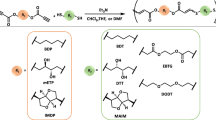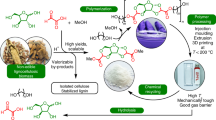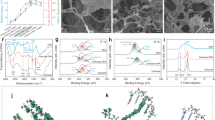Abstract
A microbial fermentation system was designed to convert glucose to 4-hydroxyphenyllactic acid (DHPA), which is an aromatic-containing derivative of lactic acid. By methylation, DHPA was transformed to a diol monomer for synthesis of bio-based polyesters with benzene rings in their backbone. The polycondensation of the DHPA diol was performed with a series of aliphatic diacid chlorides to produce semi-aromatic polyesters with glass-transition temperatures <45 °C. By polycondensation with aromatic diacylchlorides, such as terephthaloyl chloride and isophthaloyl chloride, thermally stable DHPA-based polyesters with glass-transition temperatures as high as 130 °C were obtained.
Similar content being viewed by others
Log in or create a free account to read this content
Gain free access to this article, as well as selected content from this journal and more on nature.com
or
References
Mülhaupt, R. Green polymer chemistry and bio-based plastics: dreams and reality. Macromol. Chem. Phys. 214, 159–174 (2013).
Kaneko, T., Tran, H. T., Shi, D. J. & Akashi, M. Environmentally-degradable, high-performance plastics from phenolic phytomonomers. Nat. Mater. 5, 996–970 (2006).
Williams, S. F., Martin, D. P. in Medicine and PharmacyIn Biopolymers, vol. 4 (eds Steinbüchel A. & Doi Y.) 91–103 (Wiley-VCH, Weinheim, Germany, 2005).
Gilding, D. K. & Reed, A. M. Biodegradable polymers for use in surgery - polyglycolic/poly (lactic acid) homo- and copolymers. Polymer 20, 1459–1464 (1979).
Sharon, C. & Sharon, M. Studies on biodegradation of polyethylene terephthalate: a synthetic polymer. J. Microbiol. Biotechnol. Res. 2, 248–257 (2012).
Fujita, T., Nguyen, H. D., Ito, T., Zhou, S., Osada, L., Tateyama, S., Kaneko, T. & Takaya, N. Microbial monomers custom-synthesized to build true bio-derived aromatic polymers. App. Microbiol. Biotechnol. 97, 8887–8894 (2013).
Nguyen, H. D., Jin, X., Kaneko, D. & Kaneko, T. Syntheses of high molecular weight poly(l-phenyllactic acid)s by a direct polycondensation in the presence of stable lewis acids. Chem. Lett. 40, 584–585 (2011).
Hagino, H., Nakayama, K. & Yoshida, H. Process for the production of L-tyrosineUS. Patent 3787287 (1974).
Fujii, T., Shimizu, M., Doi, Y., Fujita, T., Ito, T., Miura, D., Wariishi, H. & Takaya, N. Novel fungal phenylpyruvate reductase belongs to D-isomer-specific 2-hydroxyacid dehydrogenase family. Biochim. Biophys. Acta 1814, 1669–1676 (2011).
Kikuchi, Y., Date, M., Yokoyama, K., Umezawa, Y. & Matsui, H. Secretion of active-form Streptoverticillium mobaraense transglutaminase by Corynebacterium glutamicum: Processing of the pro-transglutaminase by a cosecreted subtilisin-like protease from Streptomyces albogriseolus. App. Env. Microbiol. 69, 358–366 (2003).
Jong, E., Dam, M. A., Sipos, L., Gruter, G.-J. M. in Biobased Monomers, Polymers, and Materials, (eds Smith P. et al., 1–13 (ACS Symposium Series; American Chemical Society, Washington, DC, USA, 2012).
Tsanaktsis, V., Papageorgiou, G. Z. & Bikiaris, D. A facile method to synthesize high-molecular-weight biobased polyesters from 2,5-furandicarboxylic acid and long-chain diols. J. Polym. Sci. A Polym. Chem. doi: 10.1002/pola.27730 (2015).
Pfefferkorn, D., Kyeremateng, S. O., Busse, K., Kammer, H. W., Thurn-Albrecht, T. & Kressler, J. Crystallization and melting of poly(ethylene oxide) in blends and diblock copolymers with poly(methyl acrylate). Macromolecules 44, 2953–2963 (2011).
Xu, J. & Guo, B. H. Poly(butylene succinate) and its copolymers: research, development and industrialization. Biotechnol. J. 5, 1149–1163 (2010).
Garlotta, D. A literature review of poly(lactic acid). J. Polym. Environ. 9, 63–84 (2011).
Parvin, M. & Williams, J. G. The effect of temperature on the fracture of polycarbonate. J. Mater. Sci. 10, 1883–1888 (1975).
Rajakuma, P.R. & Nanthini, R. Thermal and morphological behaviours of polybuthylene terephthalate/polyethylene terephthalate blend nanocomposites. Rasayan J. Chem. 4, 567–579 (2011).
Simmons, T. L. & Baker, G. L. Poly(phenyllactide): synthesis, characterization, and hydrolytic degradation. Biomacromolecules 2, 658–663 (2001).
Persson, M., Lorite, G. S., Cho, S., Tuukkanen, J. & Skrifvars, M. Melt spinning of poly(lactic acid) and hydroxyapatite composite fibers: influence of the filler content on the fiber properties. App. Mater. Int 5, 6864–6872 (2013).
Pitt, C.G. & Zhong-wei, G. Modification of the rates of chain cleavage of poly(caprolactone) and related polyester in the solid state. J. Control. Release. 4, 283–292 (1987).
Tsuji, H., Eto, T. & Sakamoto, Y. Synthesis and hydrolytic degradation of substituted poly(DL-Lactic Acid)s. Materials 4, 1384–1398 (2011).
Tsuji, H., Mizuno, A. & Ikada, Y. Properties and morphology of poly(L-lactide). III. Effects of initial crystallinity on long-term in vitro hydrolysis of high molecular weight poly(L-lactide) film in phosphate-buffered solution. J. Appl. Polym. Sci. 77, 1452–1464 (2000).
Acknowledgements
The research was financially supported by the Advanced Low Carbon Technology Research and Development Program (ALCA, 5100270) of the Japanese Science and Technology Agency (JST), and was partially promoted by COI program (Construction of next-generation infrastructure using innovative materials - Realization of a safe and secure society that can coexist with the Earth for centuries-) supported by JST, Tokyo, Japan.
Author information
Authors and Affiliations
Corresponding author
Ethics declarations
Competing interests
The authors declare no conflict of interest.
Additional information
Supplementary Information accompanies the paper on Polymer Journal website
Supplementary information
Rights and permissions
About this article
Cite this article
Nguyen, H., Kaneko, T., Takaya, N. et al. Fermentation of aromatic lactate monomer and its polymerization to produce highly thermoresistant bioplastics. Polym J 48, 81–89 (2016). https://doi.org/10.1038/pj.2015.80
Received:
Revised:
Accepted:
Published:
Issue date:
DOI: https://doi.org/10.1038/pj.2015.80
This article is cited by
-
Renewable polymeric materials for electronic applications
Polymer Journal (2017)
-
Alternative fermentation pathway of cinnamic acid production via phenyllactic acid
Applied Microbiology and Biotechnology (2016)



